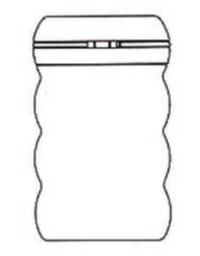In a recent decision dated March 29, 2023, the EUIPO General Court provided relevant guidance on the interpretation of the distinctive character requirement in figurative trademarks representing three-dimensional (3-D) shapes.
Facts of the proceedings
In December 2020, a European Union trademark application was filed for the following figurative sign

seeking protection for confectionery and candy products belonging to Class 30 of the Nice Classification.
The EUIPO Examiner, in a decision dated July 2021, rejected the trademark application considering the sign to be lacking of distinctive character in accordance with Article 7(1)(b) of EU Regulation 2017/1001, as subsequently also confirmed by the EUIPO Board of Appeal.
Following the appeal before the EUIPO General Court, the latter ultimately ruled in accordance with the Board of Appeal, holding that the criteria developed for three-dimensional marks, corresponding to the appearance of the product or its packaging, are also applicable to figurative trademarks consisting of a two-dimensional-even merely schematic-representation of the product or its packaging.
The arguments underlying the EUIPO General Court's decision
As a preliminary remark, it is well known that the shape of a product or its packaging can be registered as a three-dimensional EU trademark, provided that such a shape is suitable to distinguish the product realized by a company from those of other businesses. The distinctive character of a trademark must be assessed with regard to both the products and services covered by the application for registration and the impression of the relevant public, i.e. the consumers of such products and services.
Taking the above into account, in the proceedings under consideration, the General Court stated that the figurative sign, despite its two-dimensional nature, would be perceived, at least by a significant part of the relevant public, as the image of the outline of a cylindrical container with wavy lines, with three horizontal rows in the upper part. In addition, since the products covered by the trademark application are cheap and frequently purchased as they are confectionery and candy products, the attention level of the consumers at the moment of purchase would be medium at best.
As argued by the General Court, whether the fact that the sign is not prospectively represented in the EU trademark application, or whether it can also be perceived as a flat figure, or whether it does not display any wording, description, or other element that makes clear that the sign is a representation of a container, do not exclude the possibility that a significant portion of the relevant public may perceive said sign as a representation of a three-dimensional container capable of containing the goods for which protection was filed. It follows that the criteria developed for three-dimensional trademarks, consisting of the appearance of the product or its packaging, are applicable to figurative trademarks consisting of a two-dimensional representation of the product or its packaging as well. And the above applies whether the two-dimensional mark consists of a photograph, or a faithful perspective graphic reproduction of the product, or of its packaging, but also in the case of their very simple and merely schematic representation, without any perspective illustration.
The EUIPO General Court's conclusion
In light of the above, the General Court concluded that the shape represented by the sign under consideration represents a mere variation from the cylindrical wrappings and packaging normally used in the market for the products at issue, thus lacking in distinctive character and, therefore, not capable of sticking in the consumer's mind as an indicator of the products' business origin.
The content of this article is intended to provide a general guide to the subject matter. Specialist advice should be sought about your specific circumstances.

